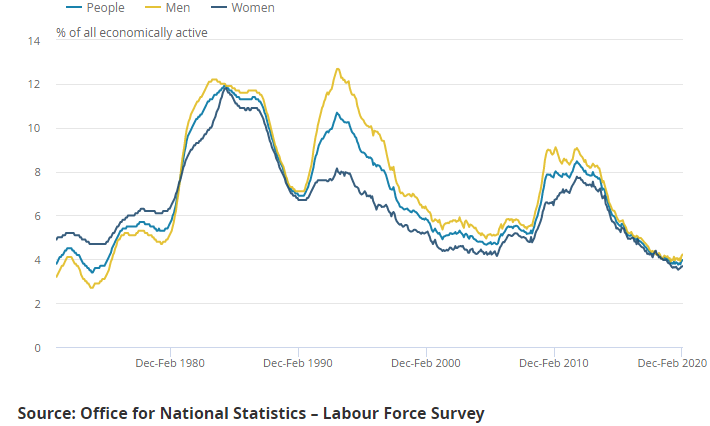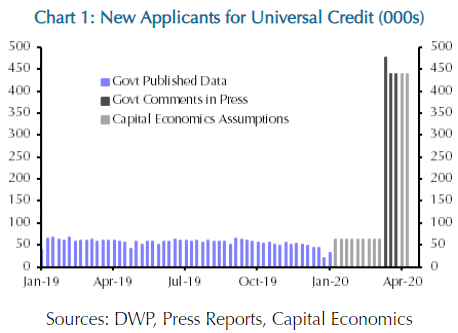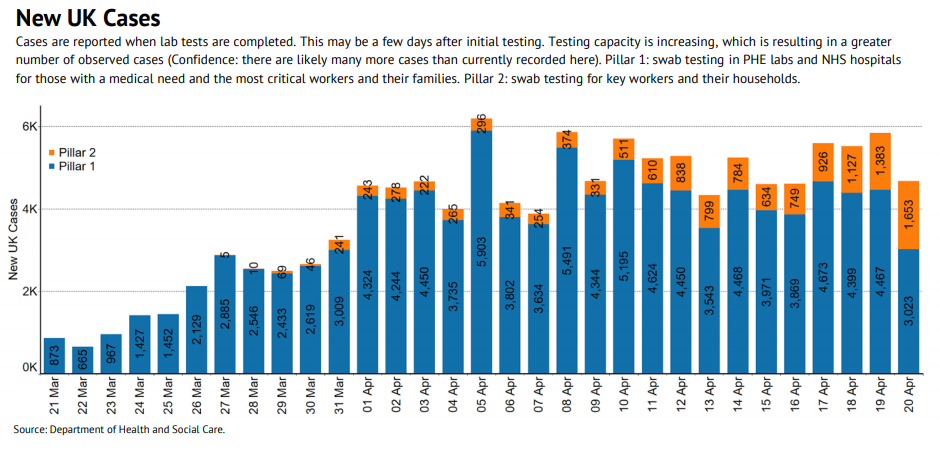UK Employment Seen at Record High Ahead of Coronavirus Carnage
- Written by: James Skinner
-
- UK employment at record in Feb but carnage looms in March, April
- Unemployment at 4% in Feb as number in work rises past 33 million.
- But 1.4 million new welfare claims threaten to put jobless rate at 8%.
- After coronavirus shutdown brings economy to a standstill in March.

© IRStone, Adobe Stock
- GBP/EUR spot at the time of writing: 1.1448
- Bank transfer rates (indicative): 1.1163-1.1243
- FX specialist rates (indicative): 1.1292-1.1361 >> More information
UK employment hit a new record in February ahead of the coronavirus shutdown, Office for National Statistics figures revealed Tuesday, but nearly 1.5 million new welfare claims since the beginning of March could push the jobless rate back up toward crisis era levels in the months ahead.
UK employment grew by 172,000 in the three months to the end of February, taking the total number of individuals in employment to 33.07 million and the employment rate to a fresh record high of 76.6%.
However, the unemployment rate also increased from 3.9% to 4% after the number of individuals classed as unemployed rose from 1.33 million to 1.36 million. This came alongside a fall in inactivity rate to a fresh record low of 20.2%, with around 8.37 million not participating in the labour force.
"The small crack evident in the latest batch of labour market data may soon turn into a chasm with the unemployment rate rising from 4% to almost 9%," says Paul Dales, chief UK economist at Capital Economics. "There’s not much here to tell us exactly how bad the fallout in the labour market is going to be. But even after taking into account the government’s furlough scheme, our estimate that the economy will contract by 25% suggests that the unemployment rate will soon leap from 4% to almost 9%."

Above: Office for National Statistics graph showing unemployment rate for population, women and men.
Tuesday's data reveals little about the impact the coronavirus has had on the labour market and economy because the data was collected on March 12, weeks before the 'lockdown' of people and economy that's since been revealed to have driven a 1.4 million increase in new welfare claimants.
Department for Work and Pensions Secretary Theresa Coffey told Sky News last week there were that many new claims as of mid-April which, based upon the information revealed Tuesday, implies an jobless rate of 8% for this month.
There would be 2.76mn unemployed after Coffey's 1.4 million new claims are taken account of which, assuming a continuous labour force size of 34.43mn, would lift the jobless rate to 8% and its highest level since June 2012.

Above: Capital Economics estimates of weekly welfare claims.
"If all 1,357,000 new claims are because people have lost their jobs, then unemployment would rise by just as much and the unemployment rate would jump from 3.9% to 7.9%," says Dales, in an early April note to clients. "Assuming that new claims stay at 440,000 a week in the first two weeks of April, then unemployment could rise by 2,237,000 and the rate would soar to 10.4%."
Economy-watchers will have to wait until Tuesday 19, May to get the official reading of what happened in March and until Tuesday 16, June for April data, which are where most of the 'lockdown' impact will show up.
However, and in practice, the eventual ONS numbers for March and April could look quite different to those above due to the way unemployment is defined as well as other quirks of the system. The ONS only counts individuals as unemployed if they are "actively looking for work" and some job losers might not be given the national shutdown, while Dales has pointed out that some welfare claimants are not necessarily newly unemployed or even unemployed at all. This might mean an 8%-to-10% unemployment rate is the worst case scenario.

Above: Government estimates of transport usage in UK.
The Office for Budget Responsibility said last week that 2 million jobs may be lost to the coronavirus by the time all is said and done. in a downturn that could see GDP fall by 35% in the second quarter and lift the jobless rate to 10%.
As a result the watchdog has projected £273bn of government borrowing for 2020 that would lift the budget deficit to 14% of GDP while raising the debt-to-gdp ratio to 95% this year and above 100% next year.
"This is only just the beginning. The unemployment rate will rise further after April as more firms can’t balance the books, are not eligible for government support or can’t access it in time," Dales says.

Above: Government disclosure of new confirmed UK coronavirus cases. 'Key workers' and families in orange.
The UK economy has ground to a standstill under the coronavirus 'lockdown' implemented on March 23 and many economists now expect large falls in GDP for the first and second quarters while there is much debate over the likely timing and shape of the recovery.
Italy, Spain and Germany, in addition to smaller countries like Austria and Denmark, have begun to lift some of the restrictions in place in their economies and where others are still in effect some are increasingly offering hope of a return to normal. Spain, the seat of Europe's largest outbreak and the second largest in the world, said over the weekend that from April 27 children will be able to go outside again subject to certain conditions but also that a third extension of the national lockdown would likely keep most people confined to homes for another three weeks.
The UK however, last in line to experience an outbreak, has offered no indication of when restrictions could be eased and due to the slow initial response to the epidemic, might be among the last to get it under control. That would indicate a more protracted period of economic pain for the UK.




